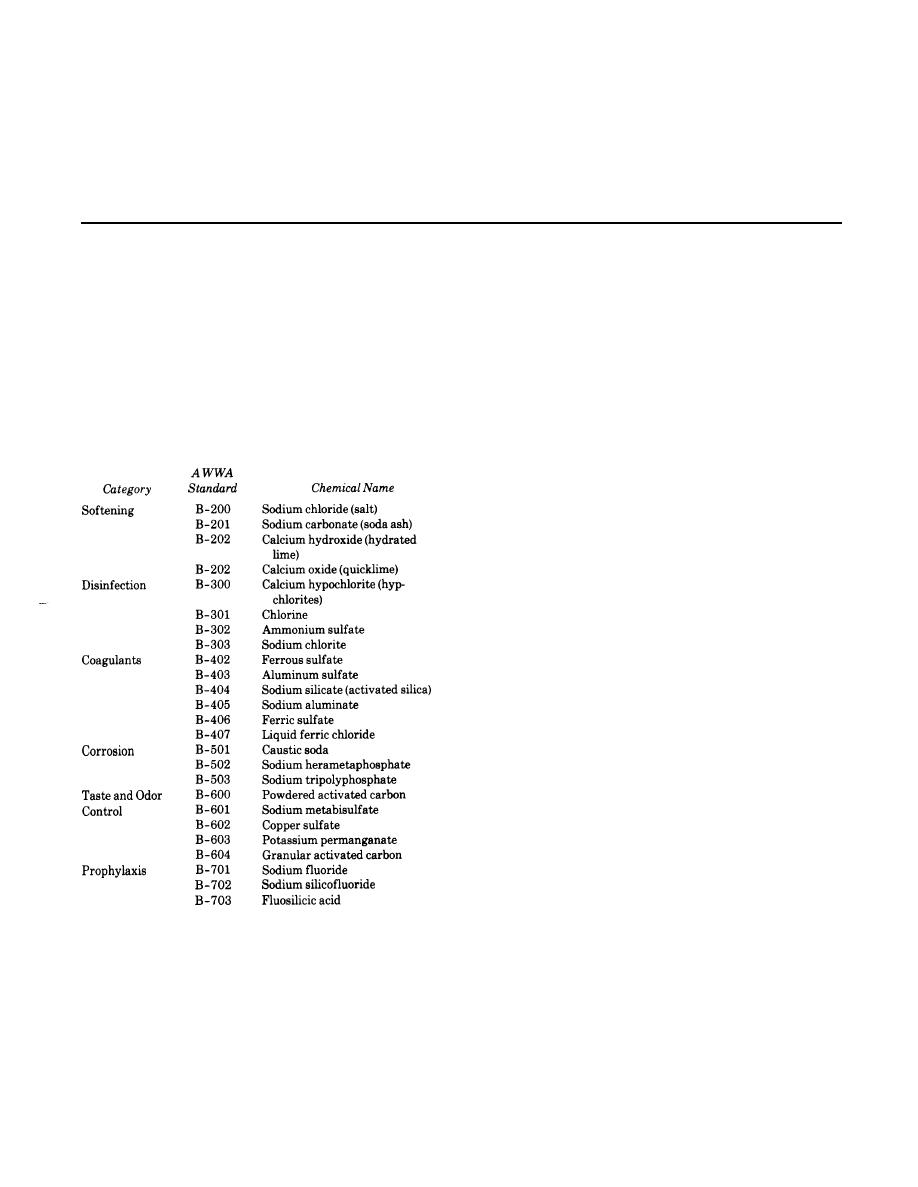
TM 5-813-3/AFM 88-10, Vol 3
CHAPTER 5
WATER TREATMENT CHEMICALS
istics of the chemical. Bulk liquids are usually unload-
5-1. Chemical properties.
ed by pumping from the tank truck or railroad car to
Chemicals are used for a variety of purposes in conven-
the storage tanks at the treatment plant. Bulk pow-
tional water treatment practice, including coagulation
ders can be unloaded by pneumatic unloading and con-
and flocculation, disinfection, fluoridation, taste and
veyance devices, or if the powder is to be mixed or dis-
odor control, and pH adjustment. The most common
solved in water, it can be unloaded directly into a wa-
chemicals and some of their characteristics are listed
ter eductor in which the powdered chemical and the
in table 5-1.
water are mixed as the water is flowing to the storage
5-2. Chemical
tank, Chemical crystals or granules are usually unload-
standards.
ed by mechanical devices, such as bucket elevators and
Chemicals used at military water treatment plants will
conveyor belts. All three forms of bulk chemicals can
meet the applicable standards of the AWWA. The
be unloaded by gravity if the chemical storage tanks or
AWWA publication number for these standards are:
bins are located below ground near the railroad tracks
or roadway. Chemicals shipped in bags, drums, bar-
rels, or other shipping containers can usually be stored
by placing these containers in a specified storage area,
Hazardous chemicals must be stored in separate rooms
to avoid reaction of chemical vapors. The supply of
chemicals in storage at a water treatment plant should
always be at least equal to the projected 30-day re-
quirements. Under some circumstances, it may be de-
sirable to maintain larger supplies of essential chemi-
cals, such as chlorine or coagulant, and smaller sup-
plies of nonessential chemicals, such as fluoridation
agents.
5-4. Chemical
application.
a. Dry chemicals. Dry chemicals are usually convert-
ed to a solution or slurry prior to application to the wa-
ter. Measurement of the chemical application rate is
accomplished by the dry-feed machine. The measured
quantity of chemical is then dissolved or slurried in a
small amount of water for transport to the feed point,
where the solution or slurry must be rapidly and thor-
oughly mixed with water being treated. Before quick-
lime can be applied to water, it must be hydrated in a
slaker. Either retention-type or paste-type slakers may
be used at military water treatment plants. If a reten-
5-3.
Chemical
handling
and
storage.
tion-type slaker is used, a temperature of 160 F or
In the design of water treatment facilities, the selec-
greater will be maintained in the slaker. All slakers
tion of methods of chemical handling and storage must
must be equipped with grit removal mechanisms.
be based primarily on ease of operation, operating flex-
b. Liquid chemicals. Chemical solutions or slurries
ibility, and safety considerations. If chemicals are to
are applied directly, or after dilution, to the water be-
be received in shipping containers such as bags, boxes,
ing treated by volumetric liquid feeders such as meter-
drums, or canisters, equipment required for chemical
ing pumps or rotating wheel feeders. Rapid, thorough
handling may include carts, dollies, fork lifts, cranes,
mixing of the chemical solution or slurry with the wa-
etc. If chemicals are shipped in bulk quantities, the
mode of unloading depends on the physical character-
ter is essential,
5-1


 Previous Page
Previous Page
